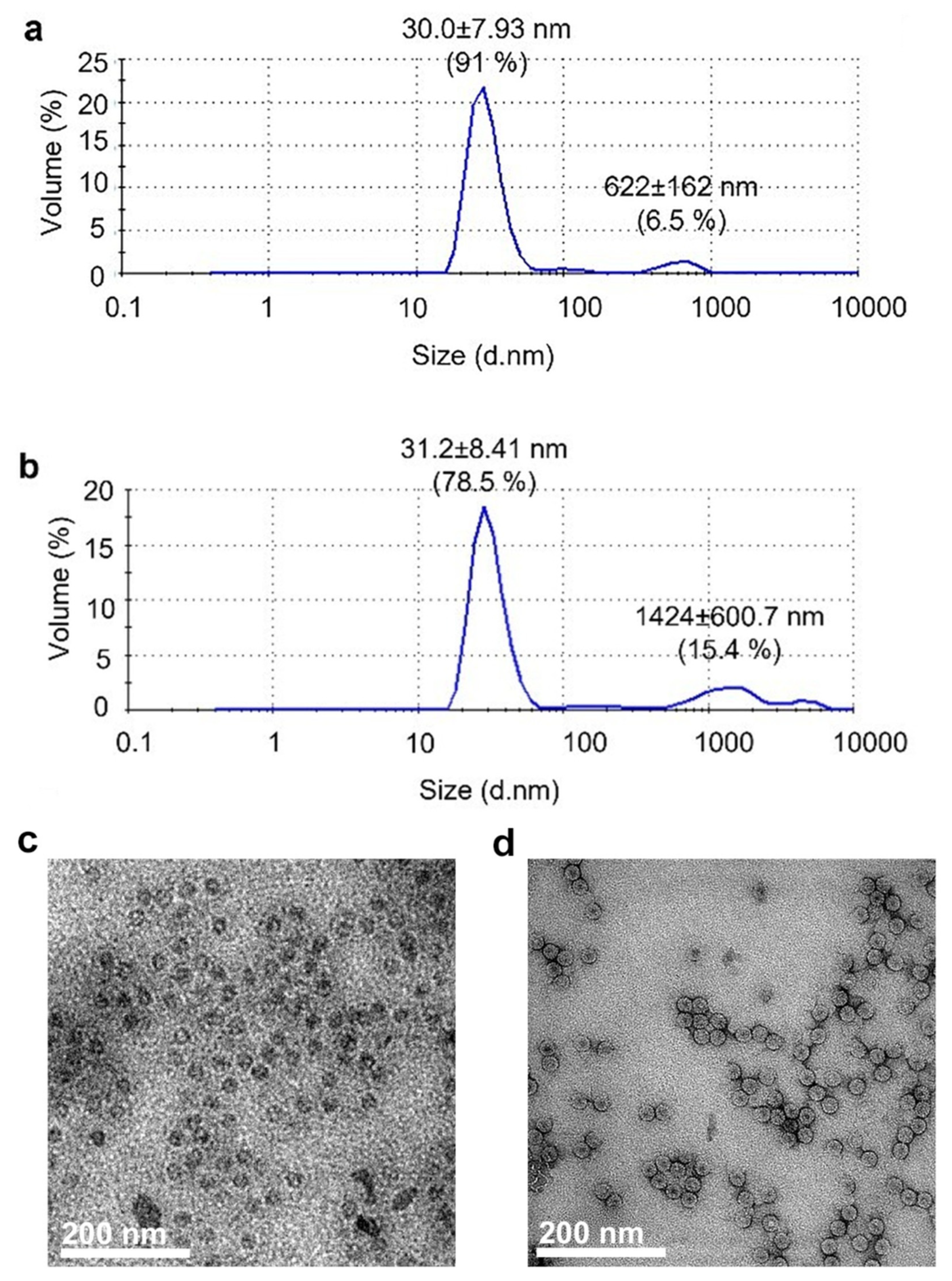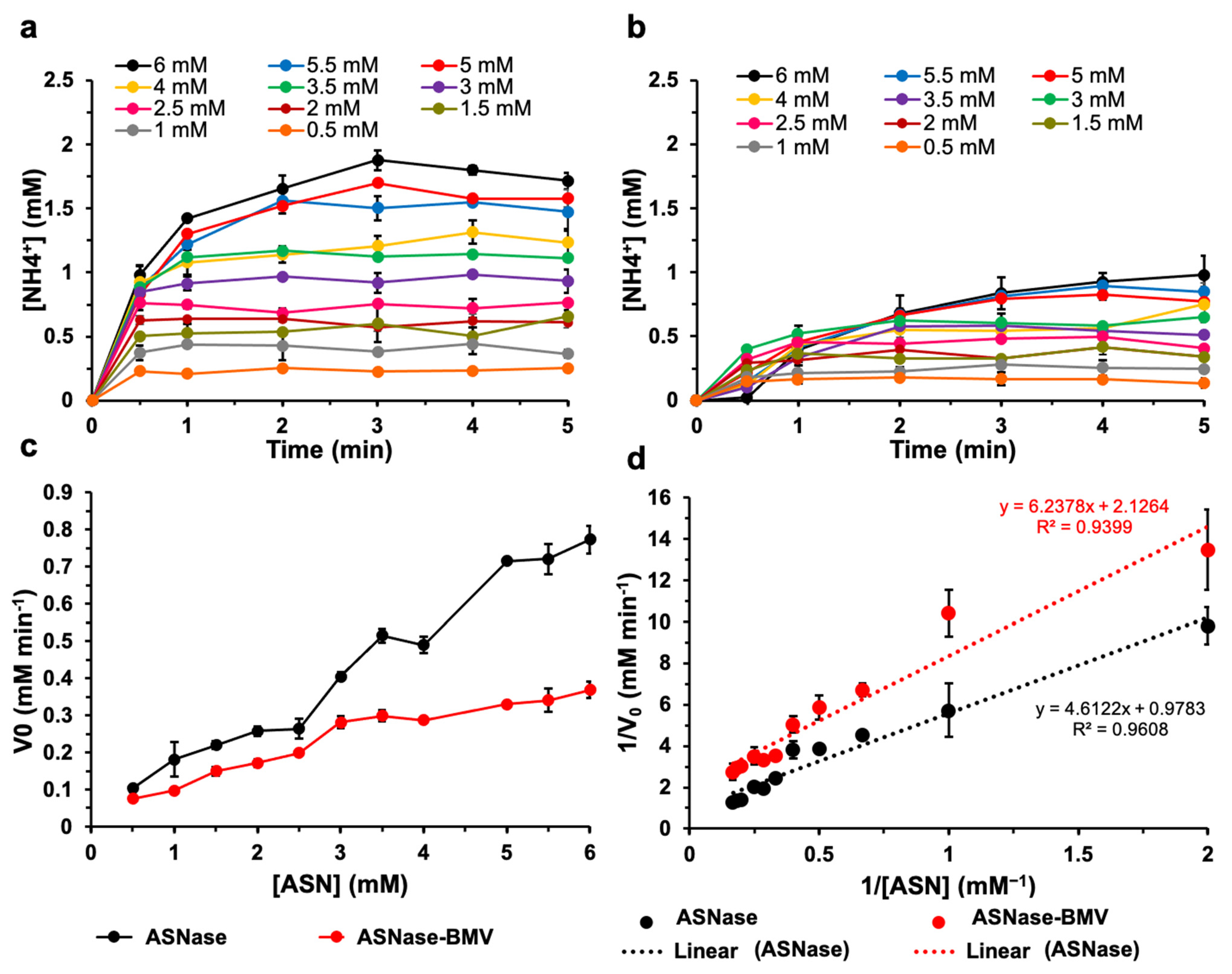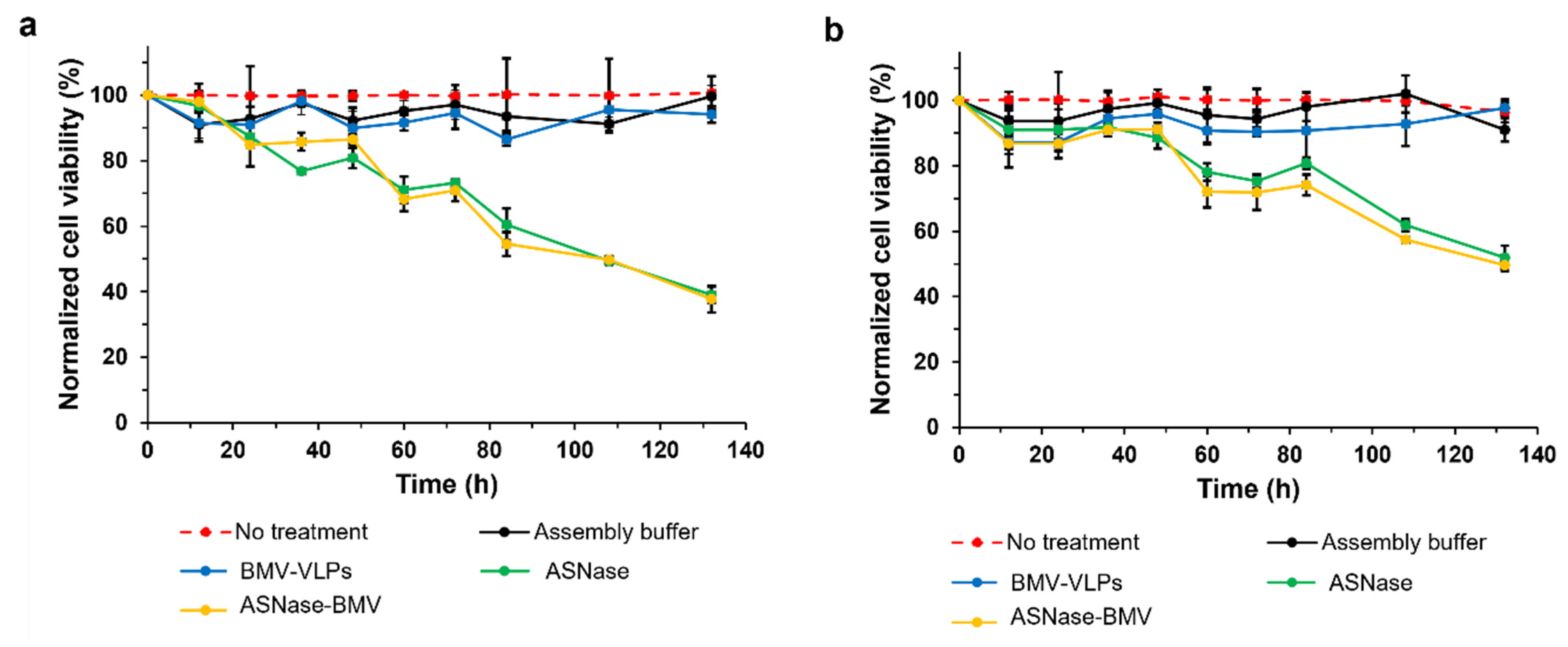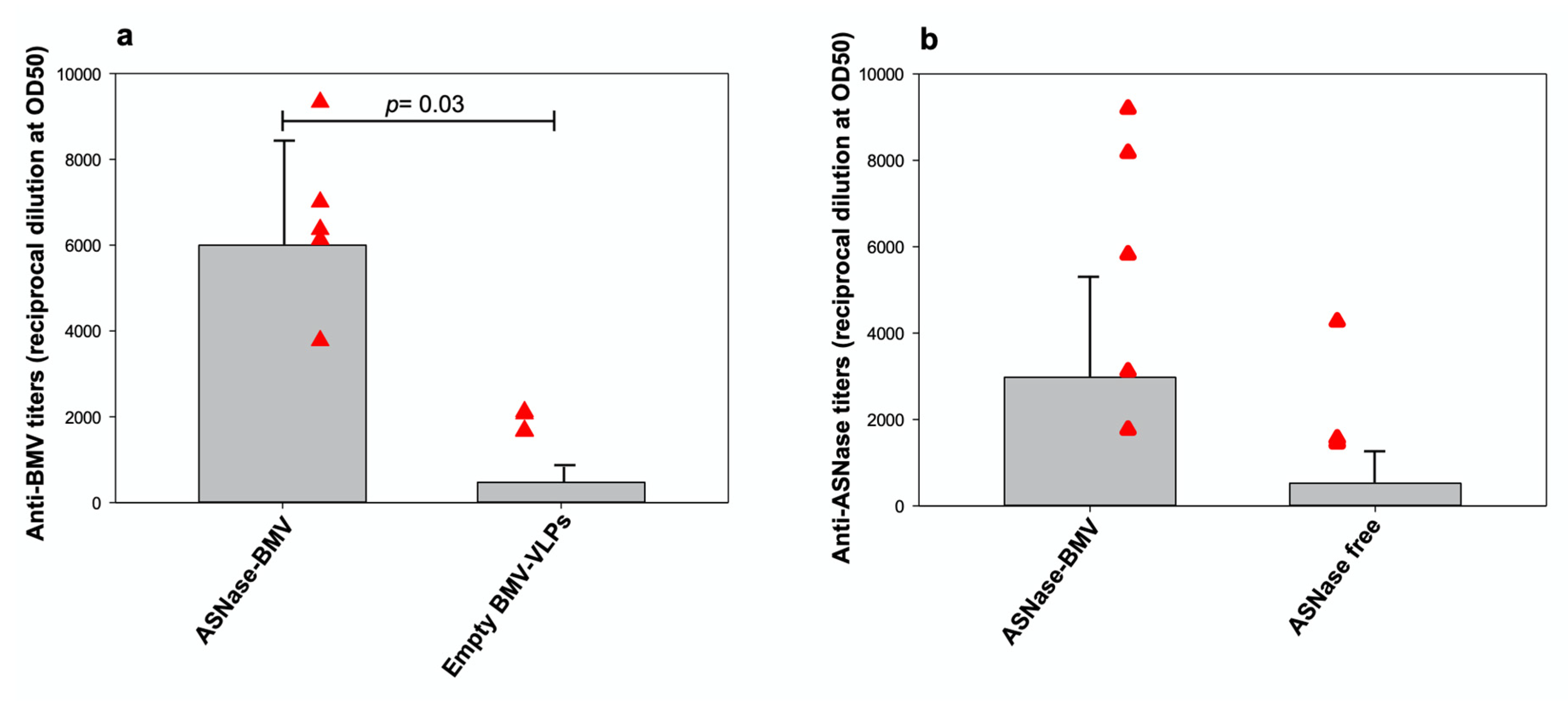A Novel Formulation of Asparaginase Encapsulated into Virus-like Particles of Brome Mosaic Virus: In Vitro and In Vivo Evidence
Abstract
1. Introduction
2. Materials and Methods
2.1. Propagation of BMV Virions
2.2. BMV Virions Purification
2.3. BMV Virions Quantification
2.4. ASNase Encapsulation into BMV-VLPs
2.5. Characterization of ASNase-BMV Nanobioreactors
2.5.1. Dynamic Light Scattering (DLS) Characterization
2.5.2. Transmission Electron Microscopy (TEM) Characterization
2.5.3. Determination of Enzymatic Activity
2.5.4. Thermal Stability
2.6. Cytotoxicity Activity of ASNase-BMV
2.6.1. Cell Culture and Cytotoxicity Assays
2.6.2. Mice Immunization
2.6.3. IgG immune Responses
2.6.4. Statistical Analysis
3. Results and Discussion
3.1. BMV-VLPs and ASNase-BMV Characterization
Size and Shape of Nanobioreactors
3.2. Asparaginase Enzymatic Characterization
3.3. Thermal Stability of Asparaginase into BMV Nanobioreactors
3.4. Cytotoxicity Evaluation of ASNase-BMV Nanobioreactors
3.5. Humoral Responses in Mice Immunized with ASNase-BMV Nanobioreactors
4. Conclusions
Author Contributions
Funding
Institutional Review Board Statement
Informed Consent Statement
Data Availability Statement
Acknowledgments
Conflicts of Interest
References
- Mandal, B.; Jain, R.K. Can plant virus infect human being? Indian J. Virol. 2010, 21, 92–93. [Google Scholar] [CrossRef] [PubMed]
- Lizotte, P.H.; Wen, A.M.; Sheen, M.R.; Fields, J.; Rojanasopondist, P.; Steinmetz, N.F.; Fiering, S. In situ vaccination with cowpea mosaic virus nanoparticles suppresses metastatic cancer. Nat. Nanotechnol. 2016, 11, 295–303. [Google Scholar] [CrossRef] [PubMed]
- Venkataraman, S.; Apka, P.; Shoeb, E.; Badar, U.; Hefferon, K. Plant Virus Nanoparticles for Anti-cancer Therapy. Front. Bioeng. Biotechnol. 2021, 9, 642794. [Google Scholar] [CrossRef] [PubMed]
- Zhang, Y.; Dong, Y.; Zhou, J.; Li, X.; Wang, F. Application of Plant Viruses as a Biotemplate for Nanomaterial Fabrication. Molecules 2018, 23, 2311. [Google Scholar] [CrossRef] [PubMed]
- Eiben, S.; Koch, C.; Altintoprak, K.; Southan, A.; Tovar, G.; Laschat, S.; Weiss, I.M.; Wege, C. Plant virus-based materials for biomedical applications: Trends and prospects. Adv. Drug. Deliv. Rev. 2019, 145, 96–118. [Google Scholar]
- Abrahamian, P.; Hammond, R.W.; Hammond, J. Plant Virus-Derived Vectors: Applications in Agricultural and Medical Biotechnology. Annu. Rev. Virol. 2020, 7, 513–535. [Google Scholar] [CrossRef] [PubMed]
- Nkanga, C.I.; Ortega-Rivera, O.A.; Shin, M.D.; Moreno-Gonzalez, M.A.; Steinmetz, N.F. Injectable Slow-Release Hydrogel Formulation of a Plant Virus-Based COVID-19 Vaccine Candidate. Biomacromolecules 2022, 23, 1812–1825. [Google Scholar] [CrossRef]
- Lico, C.; Benvenuto, E.; Baschieri, S. The Two-Faced Potato Virus X: From Plant Pathogen to Smart Nanoparticle. Front. Plant Sci. 2015, 6, 1009. [Google Scholar] [CrossRef]
- Bruckman, M.A.; Czapar, A.E.; VanMeter, A.; Randolph, L.N.; Steinmetz, N.F. Tobacco mosaic virus-based protein nanoparticles and nanorods for chemotherapy delivery targeting breast cancer. J. Control. Release 2016, 231, 103–113. [Google Scholar] [CrossRef]
- Lomonossoff, G.P.; Wege, C. TMV Particles: The Journey from Fundamental Studies to Bionanotechnology Applications. Adv. Virus Res. 2018, 102, 149–176. [Google Scholar]
- Sánchez-Sánchez, L.; Cadena-Nava, R.D.; Palomares, L.A.; Ruiz-Garcia, J.; Koay, M.S.; Cornelissen, J.J.; Vazquez-Duhalt, R. Chemotherapy pro-drug activation by biocatalytic virus-like nanoparticles containing cytochrome P450. Enzyme Microbiol. Technol. 2014, 60, 24–31. [Google Scholar] [CrossRef] [PubMed]
- Villanueva-Flores, F.; Castro-Lugo, A.; Ramírez, O.T.; Palomares, L.A. Understanding cellular interactions with nanomaterials: Towards a rational design of medical nanodevices. Nanotechnology 2020, 31, 132002. [Google Scholar] [CrossRef] [PubMed]
- Venkataraman, S.; Hefferon, K. Application of Plant Viruses in Biotechnology, Medicine, and Human Health. Viruses 2021, 13, 1697. [Google Scholar] [CrossRef] [PubMed]
- Wang, X.; Ahlquist, P. Brome Mosaic Virus. Encycl. Virol. 2008, 381–386. [Google Scholar] [CrossRef]
- Scholthof, K.B.D.; Adkins, S.; Czosnek, H.; Paulukaitis, P.; Jacquot, E.; Hohn, B.; Saunders, K.; Candresse, T.; Ahlquist, P.; Hemenway, C.; et al. Top 10 plant viruses in molecular plant pathology. Mol. Plant Pathol. 2011, 12, 938–954. [Google Scholar] [PubMed]
- Strugała, A.; Bierwagen, P.; Rybka, J.D.; Giersig, M.; Figlerowicz, M.; Urbanowicz, A. BMV Propagation, Extraction and Purification Using Chromatographic Methods. Bio-Protocol 2018, 8, e2935. [Google Scholar] [CrossRef]
- Nuñez-Rivera, A.; Fournier, P.G.J.; Arellano, D.L.; Rodriguez-Hernandez, A.G.; Vazquez-Duhalt, R.; Cadena-Nava, R.D. Brome mosaic virus-like particles as siRNA nanocarriers for biomedical purposes. Beilstein J. Nanotechnol. 2020, 11, 372–382. [Google Scholar] [CrossRef]
- Pocsai, E. Effect of Brome Mosaic C Virus infection on the plant height and weight of cereals at their early stages of growth. Cereal Res. Comm. 1987, 15, 167–174. [Google Scholar]
- He, G.; Zhang, Z.; Sathanantham, P.; Diaz, A.; Wang, X. Brome Mosaic Virus (Bromoviridae). Encycl. Virol. 2021, 3, 252–259. [Google Scholar] [CrossRef]
- Lucas, R.W.; Larson, S.B.; McPherson, A. The crystallographic structure of brome mosaic virus. J. Mol. Biol. 2002, 317, 95–108. [Google Scholar] [CrossRef]
- Lee, S.K.; Hacker, D.L. In vitro analysis of an RNA binding site within the N-terminal 30 amino acids of the southern cowpea mosaic virus coat protein. Virology 2001, 286, 317–327. [Google Scholar] [CrossRef]
- Guerra-Peraza, O.; Kirk, D.; Seltzer, V.; Veluthambi, K.; Schmit, A.C.; Hohn, T.; Herzog, E. Coat proteins of Rice tungro bacilliform virus and Mungbean yellow mosaic virus contain multiple nuclear-localization signals and interact with importin alpha. J. Gen. Virol. 2005, 86, 1815–1826. [Google Scholar] [CrossRef]
- Xu, H.; Nie, J. Identification, Characterization, and Molecular Detection of Alfalfa mosaic virus in Potato. Phytopathology 2006, 96, 1237–1242. [Google Scholar] [CrossRef] [PubMed]
- Rohovie, M.J.; Nagasawa, M.; Swartz, J.R. Virus-like particles: Next-generation nanoparticles for targeted therapeutic delivery. Bioeng. Transl. Med. 2017, 2, 43–57. [Google Scholar] [PubMed]
- Kato, Y.; Ozawa, S.; Miyamoto, C.; Maehata, Y.; Suzuki, A.; Maeda, T.; Baba, Y. Acidic extracellular microenvironment and cancer. Cancer Cell Int. 2013, 13, 89. [Google Scholar] [CrossRef] [PubMed]
- Duran-Meza, A.L.; Villagrana-Escareño, M.V.; Ruiz-García, J.; Knobler, C.M.; Gelbart, W.M. Controlling the surface charge of simple viruses. PLoS ONE 2021, 16, e0255820. [Google Scholar] [CrossRef]
- Dixit, S.K.; Goicochea, N.L.; Daniel, M.C.; Murali, A.; Bronstein, L.; De, M.; Stein, B.; Rotello, V.M.; Kao, C.C.; Dragnea, B. Quantum dot encapsulation in viral capsids. Nano Lett. 2006, 6, 1993–1999. [Google Scholar] [CrossRef]
- Huang, X.; Stein, B.D.; Cheng, H.; Malyutin, A.; Tsvetkova, I.B.; Baxter, D.V.; Remmes, N.B.; Verchot, J.; Kao, C.; Bronstein, L.M.; et al. Magnetic virus-like nanoparticles in N. benthamiana plants: A new paradigm for environmental and agronomic biotechnological research. ACS Nano 2011, 5, 4037–4045. [Google Scholar] [CrossRef] [PubMed]
- Daniel, M.C.; Tsvetkova, I.B.; Quinkert, Z.T.; Murali, A.; De, M.; Rotello, V.M.; Kao, C.C.; Dragnea, B. Role of surface charge density in nanoparticle-templated assembly of bromovirus protein cages. ACS Nano 2010, 4, 3853–3860. [Google Scholar] [CrossRef][Green Version]
- Jung, B.; Rao, A.L.; Anvari, B. Optical nano-constructs composed of genome-depleted brome mosaic virus doped with a near infrared chromophore for potential biomedical applications. ACS Nano 2011, 5, 1243–1252. [Google Scholar] [CrossRef]
- Gama, P.; Cadena-Nava, R.D.; Juarez-Moreno, K.; Pérez-Robles, J.; Vazquez-Duhalt, R. Virus-Based Nanoreactors with GALT Activity for Classic Galactosemia Therapy. Chem. Med. Chem. 2021, 16, 1438–1445. [Google Scholar] [CrossRef]
- Batool, T.; Makky, E.A.; Jalal, M.; Yusoff, M.M. A Comprehensive Review on L-Asparaginase and Its Applications. Appl. Biochem. Biotechnol. 2016, 178, 900–923. [Google Scholar] [CrossRef]
- Lubkowski, J.; Wlodawer, A. Structural and biochemical properties of L-asparaginase. FEBS J. 2021, 288, 4183–4209. [Google Scholar] [CrossRef]
- Terwilliger, T.; Abdul-Hay, M. Acute lymphoblastic leukemia: A comprehensive review and 2017 update. Blood Cancer J. 2017, 7, e577. [Google Scholar]
- Villanueva-Flores, F.; Zárate-Romero, A.; Torres, A.G.; Huerta-Saquero, A. Encapsulation of Asparaginase as a Promising Strategy to Improve In Vivo Drug Performance. Pharmaceutics 2021, 13, 1965. [Google Scholar] [CrossRef] [PubMed]
- Nuñez Rivera, A. CCMV y BMV Como Potenciales Nanovehículos en Tratamientos Contra el Cáncer de Mama. Ph.D. Thesis, Centro de Investigación Científica y de Educación Superior de Ensenada, Ensenada, BC, Mexico, 2020; 67p. [Google Scholar]
- Berthelot, M.P.E. Berthelot’s Reaction Mechanism. Rep. De Chim. Appl. 1859, 2884. [Google Scholar]
- Díaz-Barriga, C.; Villanueva-Flores, F.; Quester, K.; Zárate-Romero, A.; Cadena-Nava, R.D.; Huerta-Saquero, A. Asparaginase-Phage P22 Nanoreactors: Toward a Biobetter Development for Acute Lymphoblastic Leukemia Treatment. Pharmaceutics 2021, 13, 604. [Google Scholar] [CrossRef]
- Gasper, M.M.; Blanco, D.; Cruz, M.E.; Alonso, M.J. Formulation of L-asparaginase-loaded poly(lactide-co-glycolide) nanoparticles: Influence of polymer properties on enzyme loading, activity and in vitro release. J. Control. Release 1998, 52, 53–62. [Google Scholar] [CrossRef]
- Brumano, L.P.; da Silva, F.V.S.; Costa-Silva, T.A.; Apolinário, A.C.; Santos, J.H.P.M.; Kleingesinds, E.K.; Monteiro, G.; Rangel-Yagui, C.O.; Benyahia, B.; Junior, A.P. Development of L-Asparaginase Biobetters: Current Research Status and Review of the Desirable Quality Profiles. Front. Bioeng. Biotechnol. 2019, 6, 212. [Google Scholar] [PubMed]
- Bueno, C.Z.; Apolinário, A.C.; Duro-Castano, A.; Poma, A.; Pessoa, A., Jr.; Rangel-Yagui, C.O.; Battaglia, G. L-Asparaginase Encapsulation into Asymmetric Permeable Polymersomes. ACS Macro Lett. 2020, 9, 1471–1477. [Google Scholar] [CrossRef] [PubMed]
- Zhou, H.X.; Rivas, G.; Minton, A.P. Macromolecular crowding and confinement: Biochemical, biophysical, and potential physiological consequences. Annu. Rev. Biophys. 2008, 37, 375–397. [Google Scholar] [CrossRef]
- Norris, M.G.; Malys, N. What is the true enzyme kinetics in the biological system? An investigation of macromolecular crowding effect upon enzyme kinetics of glucose-6-phosphate dehydrogenase. Biochem. Biophys. Res. Comm. 2011, 405, 388–392. [Google Scholar] [CrossRef] [PubMed]
- Patterson, D.P.; Prevelige, P.E.; Douglas, T. Nanoreactors by programmed enzyme encapsulation inside the capsid of the bacteriophage P22. ACS Nano 2012, 6, 5000–5009. [Google Scholar] [CrossRef] [PubMed]
- Doğaç, Y.I.; Çinar, M.; Teke, M. Improving of catalase stability properties by encapsulation in alginate/Fe3O4 magnetic composite beads for enzymatic removal of H2O2. Prep. Biochem. Biotechnol. 2015, 45, 144–157. [Google Scholar] [CrossRef] [PubMed]
- Das, S.; Zhao, L.; Elofson, K.; Finn, M.G. Enzyme Stabilization by Virus-Like Particles. Biochemistry 2020, 59, 2870–2881. [Google Scholar] [CrossRef]
- Song, M.; Chang, J.H. Thermally Stable and Reusable Ceramic Encapsulated and Cross-Linked CalB Enzyme Particles for Rapid Hydrolysis and Esterification. Int. J. Mol. Sci. 2022, 23, 2459. [Google Scholar] [CrossRef]
- Hutson, R.G.; Kitoh, T.; Moraga Amador, D.A.; Cosic, S.; Schuster, S.M.; Kilberg, M.S. Amino acid control of asparagine synthetase: Relation to asparaginase resistance in human leukemia cells. Am. J. Physiol. 1997, 272, C1691–C1699. [Google Scholar] [CrossRef] [PubMed]
- Aslanian, A.M.; Kilberg, M.S. Multiple adaptive mechanisms affect asparagine synthetase substrate availability in asparaginase-resistant MOLT-4 human leukaemia cells. Biochem. J. 2001, 358, 59–67. [Google Scholar] [CrossRef]
- Su, N.; Pan, Y.X.; Zhou, M.; Harvey, R.C.; Hunger, S.P.; Kilberg, M.S. Correlation between asparaginase sensitivity and asparagine synthetase protein content, but not mRNA, in acute lymphoblastic leukemia cell lines. Pediatr. Blood Cancer 2008, 50, 274–279. [Google Scholar] [CrossRef] [PubMed]
- Husain, I.; Sharma, A.; Kumar, S.; Malik, F. Purification and Characterization of Glutaminase Free Asparaginase from Enterobacter cloacae: In-Vitro Evaluation of Cytotoxic Potential against Human Myeloid Leukemia HL-60 Cells. PLoS ONE 2016, 11, e0148877. [Google Scholar] [CrossRef]
- Zinkhan, S.; Ogrina, A.; Balke, I.; Resevi, G.; Zeltins, A.; de Brot, S.; Lipp, C.; Chang, X.; Zha, L.; Vogel, M.; et al. The impact of size on particle drainage dynamics and antibody response. J. Control. Release 2021, 331, 296–308. [Google Scholar] [CrossRef] [PubMed]
- Shukla, S.; Wang, C.; Beiss, V.; Steinmetz, N.F. Antibody Response against Cowpea Mosaic Viral Nanoparticles Improves in situ Vaccine Efficacy in Ovarian Cancer. ACS Nano 2020, 14, 2994–3003. [Google Scholar] [CrossRef] [PubMed]





| Enzyme | KM (mM) | Vmax (mM min−1) | Kcat × 1011 (min−1) | Vmax/KM (min−1) | Kcat/KM × 1010 (mM−1 min−1) |
|---|---|---|---|---|---|
| ASNase (free) | 2.83 | 1.02 | 1.56 | 0.36 | 5.51 |
| ASNase-BMV nanobioreactors | 4.71 | 0.47 | 0.72 | 0.10 | 1.53 |
| Days Post First Immunization | |||||
|---|---|---|---|---|---|
| Mice Groups | Description | 7th | 21st | 35th | 42nd |
| A | Anti-BMV-VLPs (empty capsids) | 8.1 ± 6.0 | 204.4 ± 107.0 | 418.8 ± 201.2 | 470.6 ± 275.9 |
| B | Anti-BMV (ASN-BMV) | 52.3 ± 43.6 | 3471.9 ± 3355.4 | 5449.3 ± 3024.5 | 5995.5 ± 2348.9 |
| Days Post First Immunization | |||||
|---|---|---|---|---|---|
| Mice Groups | Description | 7th | 21st | 35th | 42th |
| B | Anti-ASNase (ASN-BMV) | 63.5 ± 43.5 | 727.1 ± 419.7 | 1529.1 ± 1210.7 | 2973.6 ± 2195.7 |
| D | Anti-ASNase (free ASN) | 16.5 ± 18.5 | 125.6 ± 216.5 | 492.8 ± 928 | 521.8 ± 852.4 |
Disclaimer/Publisher’s Note: The statements, opinions and data contained in all publications are solely those of the individual author(s) and contributor(s) and not of MDPI and/or the editor(s). MDPI and/or the editor(s) disclaim responsibility for any injury to people or property resulting from any ideas, methods, instructions or products referred to in the content. |
© 2023 by the authors. Licensee MDPI, Basel, Switzerland. This article is an open access article distributed under the terms and conditions of the Creative Commons Attribution (CC BY) license (https://creativecommons.org/licenses/by/4.0/).
Share and Cite
Villanueva-Flores, F.; Pastor, A.R.; Palomares, L.A.; Huerta-Saquero, A. A Novel Formulation of Asparaginase Encapsulated into Virus-like Particles of Brome Mosaic Virus: In Vitro and In Vivo Evidence. Pharmaceutics 2023, 15, 2260. https://doi.org/10.3390/pharmaceutics15092260
Villanueva-Flores F, Pastor AR, Palomares LA, Huerta-Saquero A. A Novel Formulation of Asparaginase Encapsulated into Virus-like Particles of Brome Mosaic Virus: In Vitro and In Vivo Evidence. Pharmaceutics. 2023; 15(9):2260. https://doi.org/10.3390/pharmaceutics15092260
Chicago/Turabian StyleVillanueva-Flores, Francisca, Ana Ruth Pastor, Laura A. Palomares, and Alejandro Huerta-Saquero. 2023. "A Novel Formulation of Asparaginase Encapsulated into Virus-like Particles of Brome Mosaic Virus: In Vitro and In Vivo Evidence" Pharmaceutics 15, no. 9: 2260. https://doi.org/10.3390/pharmaceutics15092260
APA StyleVillanueva-Flores, F., Pastor, A. R., Palomares, L. A., & Huerta-Saquero, A. (2023). A Novel Formulation of Asparaginase Encapsulated into Virus-like Particles of Brome Mosaic Virus: In Vitro and In Vivo Evidence. Pharmaceutics, 15(9), 2260. https://doi.org/10.3390/pharmaceutics15092260







